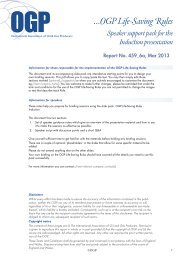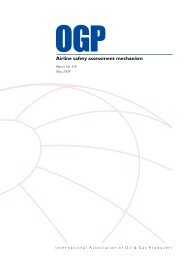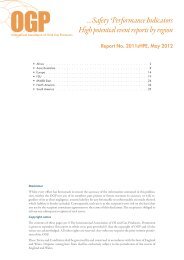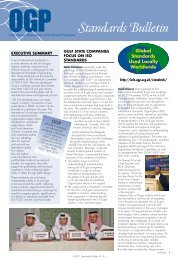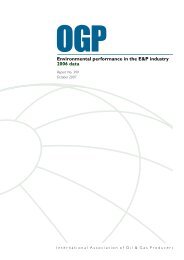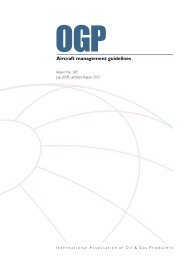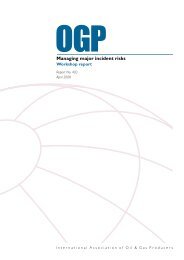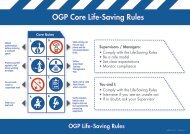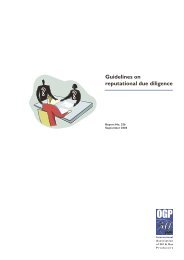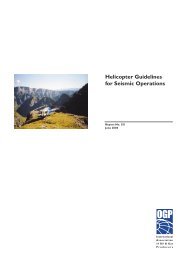Helicopter guidelines for land seismic & helirig operations - OGP
Helicopter guidelines for land seismic & helirig operations - OGP
Helicopter guidelines for land seismic & helirig operations - OGP
Create successful ePaper yourself
Turn your PDF publications into a flip-book with our unique Google optimized e-Paper software.
<strong>Helicopter</strong> <strong>guidelines</strong> <strong>for</strong> <strong>land</strong> <strong>seismic</strong> & <strong>helirig</strong> <strong>operations</strong><br />
Hazard description<br />
• Birds in flight, risk of collision<br />
• Snakes<br />
• Scorpions<br />
• Insects<br />
• African bees<br />
• May affect personnel on the ground, but may<br />
also get into the aircraft and present a risk to<br />
passengers and pilots inside.<br />
• Noise may disturb wildlife<br />
Suggested controls<br />
• Avoid positioning helipads near high<br />
concentrations of birds<br />
• Map out locations with high concentrations of<br />
birds and make pilots aware of these locations.<br />
• Housekeeping: avoid birds of pray or scavengers<br />
being attracted to helipads<br />
• Common protective measures against insects.<br />
• Eliminate bee hives.<br />
• Avoid cargo being put on bare ground, use<br />
elevated plat<strong>for</strong>ms<br />
• Avoid overflyingf protected areas etc.<br />
G.2 Operational hazards & suggested controls<br />
Operating envelope<br />
Hazard description<br />
All helicopters have limits in terms of:<br />
• range<br />
• capacity<br />
• lifting<br />
• altitude<br />
Suggested controls<br />
• Lifting capacity is function of air density, which in<br />
turn is influenced by temperature and altitude.<br />
• Determine the safe working envelope of the<br />
helicopter.<br />
• Deploy within safe operating envelope of<br />
helicopter.<br />
• Beware of ìimprovisationî and unplanned, illconsidered<br />
use.<br />
• Develop Manual of Permitted Operations<br />
• Develop load tables as function of temperature<br />
and altitude<br />
Aircraft integrity<br />
Hazard description<br />
Mechanical failure<br />
Foreign Object Damage (FOD)<br />
Collision with obstacles.<br />
• Higher ground or obstacles near <strong>land</strong>ing point<br />
• Overhead power lines, antennas<br />
• High buildings<br />
• Terrain<br />
• Other aircraft<br />
Suggested controls<br />
It is self evident that adequate maintenance and<br />
repair are essential. Aircraft maintenance as such etc<br />
is a specialist and large subject, not addressed here<br />
and normally covered in aircraft manuals etc.<br />
However, the following must be noted as provisions<br />
that must be considered <strong>for</strong> <strong>land</strong> helicopter support<br />
<strong>operations</strong>:<br />
• Hangar<br />
• Storage of spare parts, some of which may need<br />
air-conditioning<br />
• A frame or other lifting device<br />
• Rolling jack to move aircraft<br />
• Stock of essential spare parts and supply line of<br />
these from manufacturer.<br />
Dirt or loose objects may be sucked into the air inlets<br />
of the engines or collide with and damage the rotors<br />
or other aircraft parts. To avoid FOD:<br />
• housekeeping around <strong>land</strong>ing areas<br />
• packaging of certain types of cargo (such as<br />
cement bags) in sealed plastic bags or containers.<br />
• Mark high points visibly and/or with stroboscope<br />
lights<br />
• Position <strong>land</strong>ing points on flat ground, without<br />
high obstacles near by, allowing a safe flight path.<br />
• Provide map of obstacles, such as power lines and<br />
antennas, towers etc.<br />
• Mark power lines with balls<br />
• Flight control, notification/coordination with other<br />
aircraft operators (crop spraying, recreational and<br />
other small aircraft, military aircraft and exercises<br />
etc.)<br />
Passenger transport<br />
© <strong>OGP</strong><br />
67



